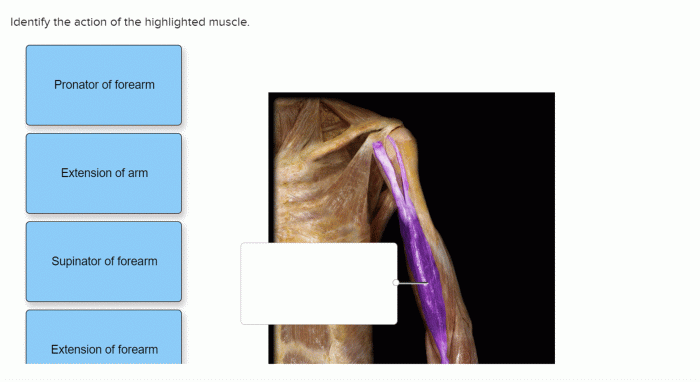Identify the action of the highlighted muscle – Delving into the realm of muscle actions, this comprehensive guide unravels the intricate interplay between muscles and movement, providing a profound understanding of their critical role in daily activities, exercise, and rehabilitation. Embark on a journey to identify the actions of highlighted muscles, empowering you with the knowledge to optimize performance, prevent injuries, and enhance overall well-being.
Understanding muscle actions is paramount for effective exercise prescription and injury management. By deciphering the specific actions of individual muscles, we can tailor training programs to target specific muscle groups, maximizing strength gains, and improving athletic performance. Moreover, identifying muscle actions plays a crucial role in injury prevention by ensuring proper biomechanics and reducing the risk of muscle strains and tears.
Understanding Muscle Actions: Identify The Action Of The Highlighted Muscle

Muscle actions are the movements produced by muscles. Understanding these actions is essential for proper exercise, rehabilitation, and athletic performance. There are three main types of muscle actions:
- Concentric actions: The muscle shortens as it produces force, causing the joint to move in the same direction as the muscle pull.
- Eccentric actions: The muscle lengthens as it produces force, causing the joint to move in the opposite direction of the muscle pull.
- Isometric actions: The muscle produces force without changing length, causing the joint to remain stationary.
Muscle actions can be identified by observing the movement of the joint and the direction of the muscle pull. For example, when you bend your elbow, the biceps muscle shortens and produces force, causing the elbow joint to flex. This is a concentric action.
Identifying Muscle Actions
Identifying the action of a highlighted muscle is a crucial step in understanding its function and role in movement. This process involves:
- Determining the anatomical position: The anatomical position is the standard reference point for describing body movements. It involves standing upright with the arms at the sides and the palms facing forward.
- Observing the joint movement: Identify the direction of the joint movement and the plane in which it occurs.
- Matching the muscle action to the joint movement: Determine the type of muscle action (concentric, eccentric, or isometric) that corresponds to the observed joint movement.
Understanding muscle actions is essential for proper exercise and rehabilitation. It allows healthcare professionals to design targeted exercises that strengthen or rehabilitate specific muscles and improve overall movement patterns.
Applications of Muscle Action Identification, Identify the action of the highlighted muscle
Identifying muscle actions has numerous applications in various fields:
- Athletic performance: Understanding muscle actions can help athletes optimize their training programs to improve strength, speed, and power.
- Injury prevention and rehabilitation: Identifying muscle imbalances or weakness can help prevent injuries and facilitate effective rehabilitation.
- Physical therapy: Physical therapists use muscle action identification to develop personalized treatment plans for patients with movement disorders or injuries.
- Fitness: Fitness professionals use muscle action identification to design exercise programs that target specific muscle groups and achieve desired fitness goals.
- Sports medicine: Sports medicine professionals use muscle action identification to evaluate and treat sports-related injuries and improve athletic performance.
Advanced Concepts in Muscle Action Analysis
Advanced muscle action analysis techniques include:
- Muscle synergy: The concept of muscle synergy refers to the coordinated activation of multiple muscles to produce a specific movement.
- Electromyography (EMG): EMG is a technique used to measure the electrical activity of muscles, providing insights into their activation patterns during movement.
These advanced techniques are used in research and clinical practice to further understand muscle function, movement biomechanics, and the development of effective interventions for movement disorders and rehabilitation.
FAQ Overview
What are the different types of muscle actions?
Muscle actions can be classified into three main types: concentric, eccentric, and isometric. Concentric actions involve muscle shortening, eccentric actions involve muscle lengthening, and isometric actions involve muscle tension without a change in length.
How can I identify the action of a highlighted muscle?
To identify the action of a highlighted muscle, consider its anatomical position, the direction of joint movement it produces, and the type of muscle contraction involved (concentric, eccentric, or isometric).
Why is it important to understand muscle actions?
Understanding muscle actions is crucial for proper exercise prescription, injury prevention, and rehabilitation. It allows us to target specific muscle groups effectively, reduce the risk of muscle strains and tears, and optimize athletic performance.

